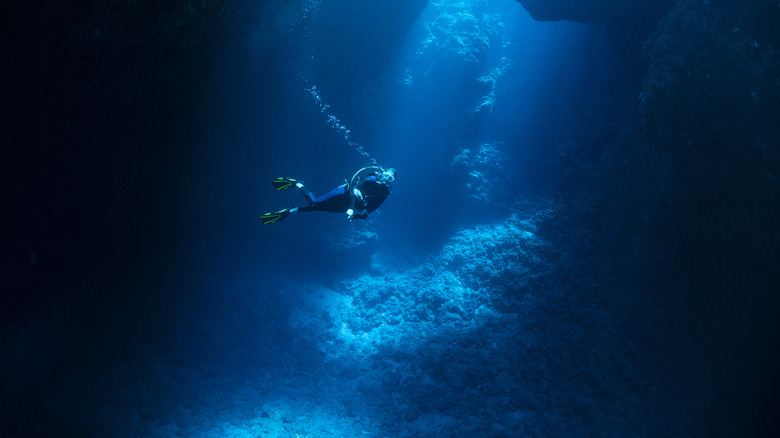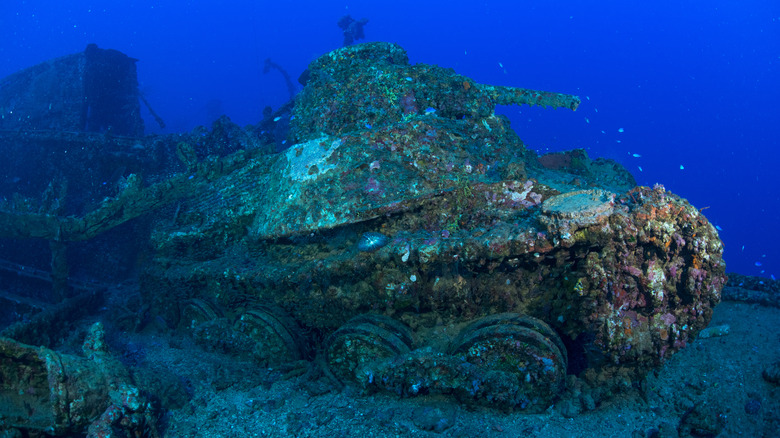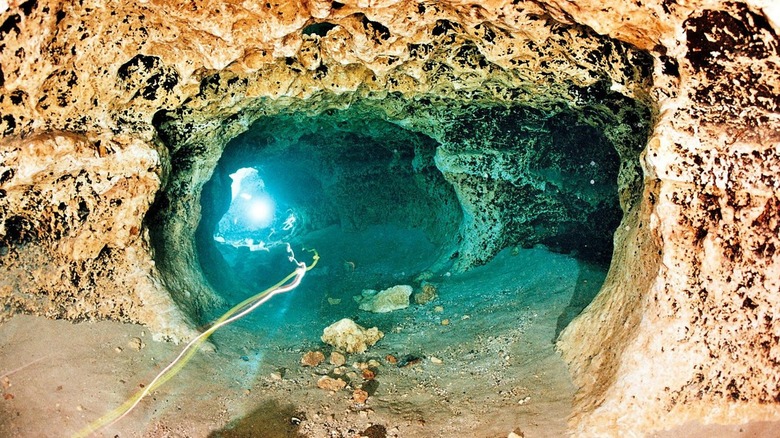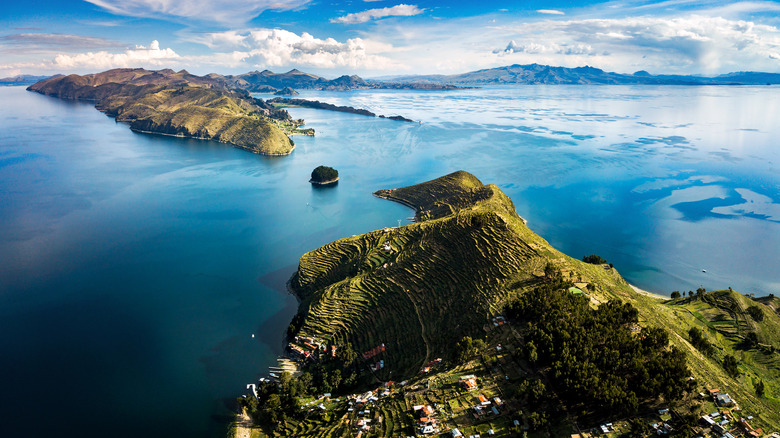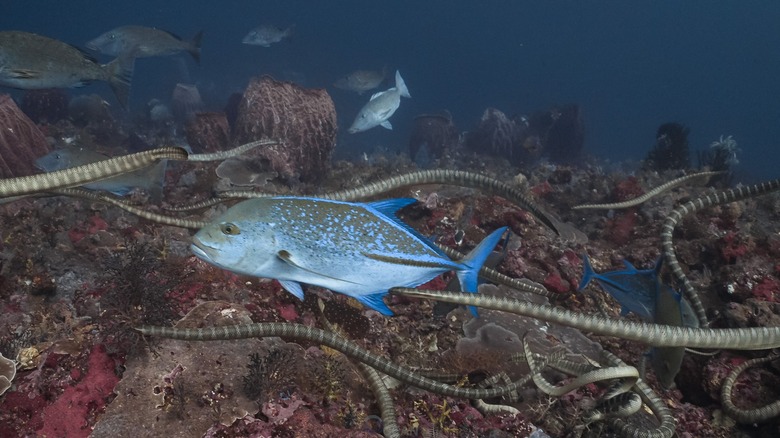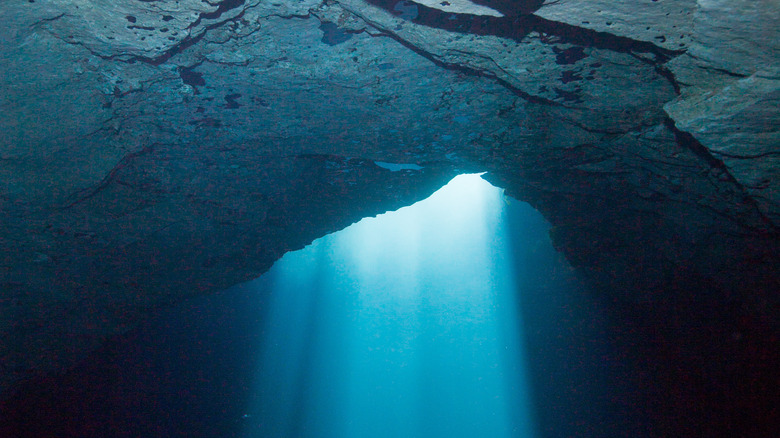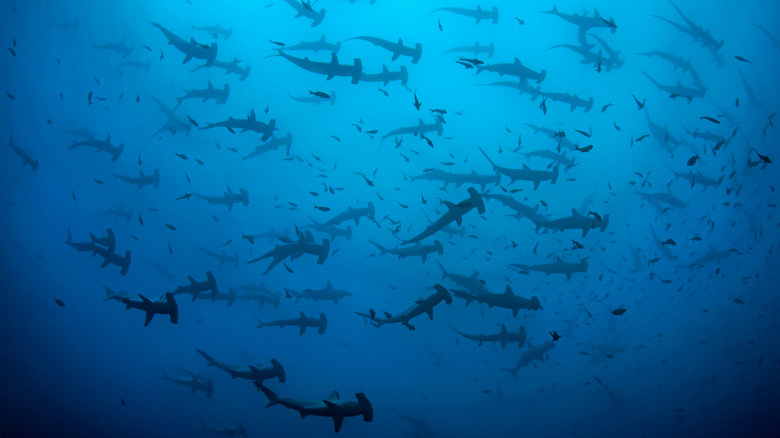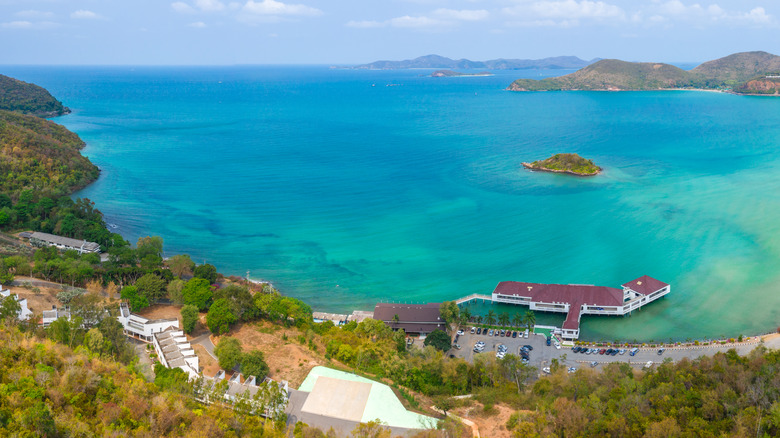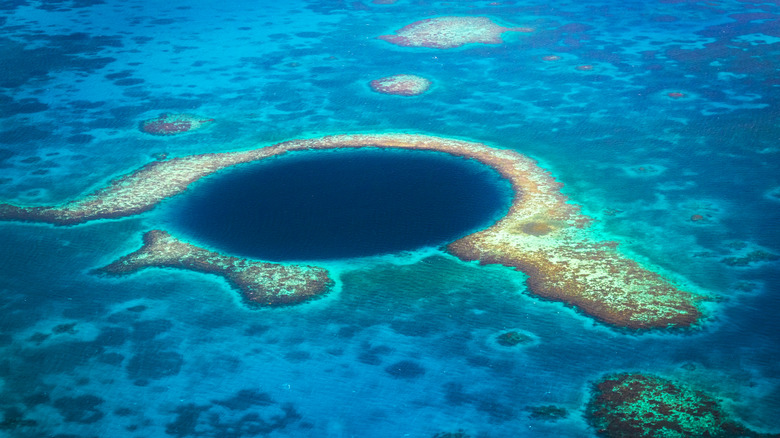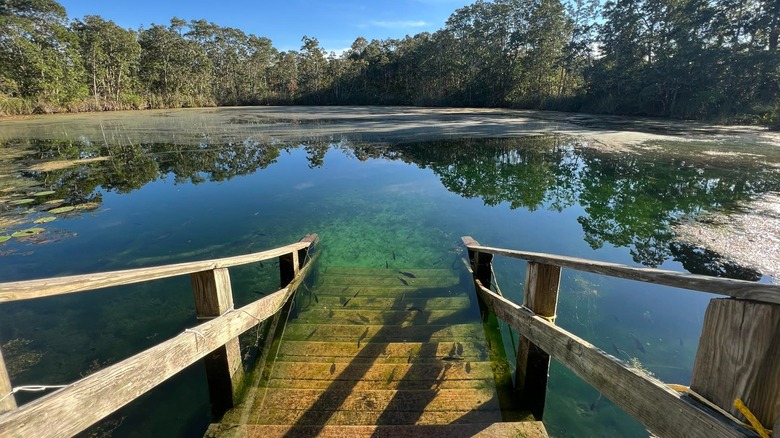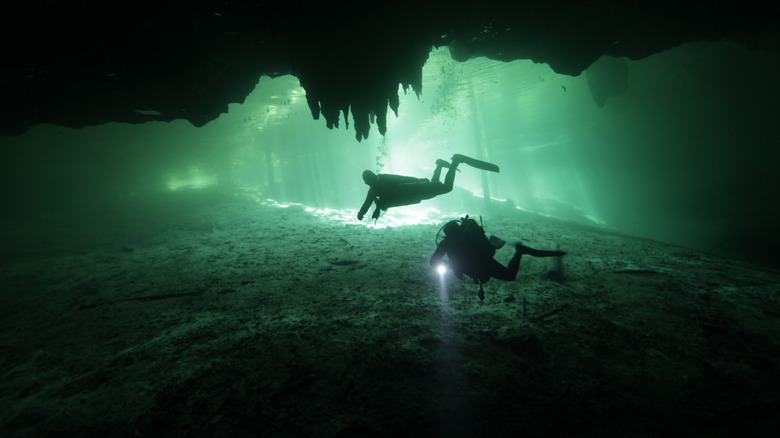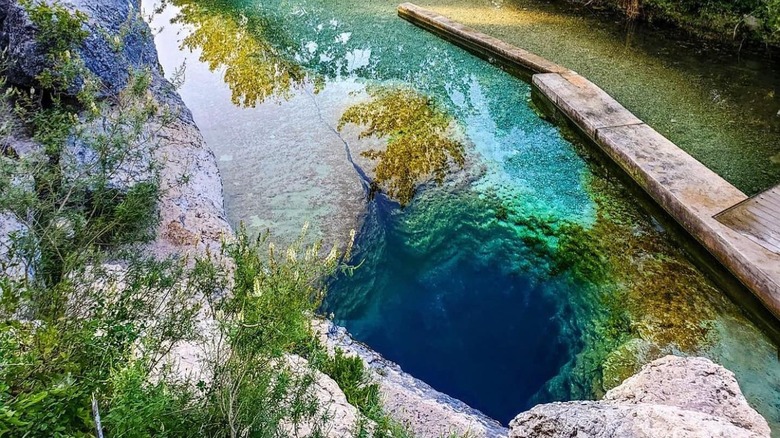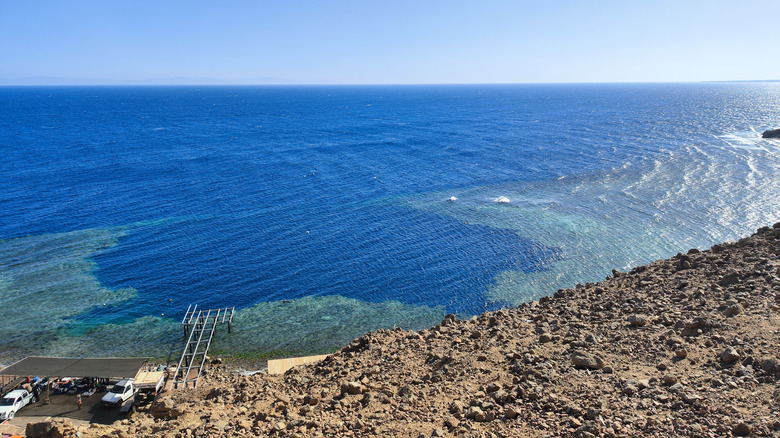12 Most Dangerous Dive Sites In The World
Scuba diving is one of the most freeing experiences you'll find on this great big Earth. Diving into the blue waters of an ocean, lake, river, or sea and utilizing modern technology to traverse the murky depths is tantalizingly addictive. Indeed, whether you're catching a run of fish — which could easily rise to number in the tens of thousands in some locales — forming into a dense wall of aquatic bodies or exploring a wreck, there's always something fascinating to see below the surface. Marine life can also provide an adrenaline rush for divers. Encounters with sharks, massive turtles, and the occasional octopus are often highlights for divers.
Dangerous dives can also be an adrenaline rush. For example, a bone-chilling night dive off the coast of Hawaii's Kona island demands nerves of steel and excellent diving chops. What makes dangerous conditions so compelling is the complexity involved. Depth is often a feature of an extreme dive. Below 30 meters (about 100 feet), nitrogen narcosis begins to set in, disorienting divers and adding to the hazards present. Narcosis is an intoxicating sensation that affects all divers, regardless of experience.
Even with plenty of varied experience, with over a decade of diving under this writer's belt, narcosis is something taken extremely seriously. In addition to depth, these dangerous sites — listed from challenging to downright dangerous — share numerous commonalities. These include strong currents and technically demanding cave structures. Needless to say, they're not for the faint of heart or the inexperienced.
1. San Francisco Maru - Chuuk Lagoon, Micronesia
The Federated States of Micronesia is a Pacific Island nation comprised of over 600 individual islands. Its territorial waters are north and northeast of Papua New Guinea and spread across a large stretch just north of the equator. Here, warm waters lend themselves brilliantly to thriving marine life and vivid undersea exploration opportunities. The tiny islands that dot the South Pacific support immense reef systems and a variety of changing landscapes beneath the wash that create a truly rich tapestry of environments that scuba divers fall in love with. One such environment is the Chuuk Lagoon.
The San Francisco Maru is a passenger ship that was sunk here in 1944. The Lagoon served as a Japanese naval base during World War II, and hundreds of Japanese vessels (275 aircraft and over 40 ships) were lost in an Allied bombing effort, resulting in the now-famous dive site decades later.
Wreck dives are always a tricky proposition. For one thing, they're often found in deep water, and the San Francisco Maru is no exception. The vessel's deck sits 49 meters (about 160 feet) below the surface. Even though the deck rests beyond the limit of recreationally advanced divers, with good visibility, it's still viable. The trouble with this wreck (and every wreck dive) is the allure of inching continually closer to the structure. A dive master may feel comfortable in taking experienced divers down to the 40-meter threshold, but the added distance increases the odds of mistakes and a hard contact with the wreck could spell disaster for a diver's oxygen rig, mask, and other essential gear.
2. The Devil's Caves - Ginnie Springs, Florida
The Devil's Spring System is a large subterranean set of caves with three large springs, which combine to produce phenomenal exploring opportunities (and 80 million gallons of water every day). The caves can be found a short drive northwest of Gainesville, Florida, and the three caves — Little Devil, Devil's Eye, and Devil's Ear — all offer breathtaking dive experiences. The spring water is consistently warm all year, and the clarity defies belief. From the bottom of the "Little Devil" cave, divers can look up through roughly 15 meters (50 feet) of spring water to see the trees that grow above the surface.
The Devil's Ear cavern is particularly hazardous for those without cave diving experience. The opening is found right at the meeting of the spring systems and the Santa Fe River, creating a vortex of water that's nearly as strong as a fire hydrant. The vortex can cause divers to lose control of their buoyancy or even dislodge gear. Multiple accidents in the cave system have resulted in fatalities through the years.
This is an unfortunate reality in the world of cave diving. Underwater structures pose a unique threat to the well-being of divers. In open-water dive environments, an emergency ascent is virtually always possible. Blasting air into a buoyancy control device (BCD) and dropping weights makes for a quick ascent, bringing distressed divers back to the oxygenated surface rapidly. In Ginnie Springs and other cave systems, however, this isn't possible, making for a breathtaking dive but rife with hazards.
3. Lake Titicaca - Bolivia and Peru
Lake Titicaca is commonly known as the highest navigable water body in the world, and it's a remarkably beautiful lake. Surrounding the lake are numerous ruins, and divers who've had the privilege to explore beneath its surface may have even seen some of the submerged remnants of ancient human activity.
The lake itself isn't a particularly dangerous place to dive, but the altitude poses a unique and striking health risk for anyone considering the activity. Lake Titicaca is found 12,500 feet (3,810 meters) above sea level, adding a substantial altitude complication to any dive planning efforts. At this height, atmospheric pressure plays a massive role in the depth that a diver can achieve beneath the surface.
At 0.64 atmospheres, a 40-meter (131-foot) descent should instead be calculated as if it were a 63-meter dive (207 feet), massively altering the decompression and safety stop landscape at play. This influences repeat dives and safety stop requirements. For example, on a typical dive, the group will pause for three to five minutes at about a 15-foot depth when reaching down below the 32-foot threshold, regardless of required stops. The high altitude can alter these requirements. Also, PADI dive tables also note that for a high altitude, mandatory decompression stop dive, divers should wait more than 18 hours before getting on a plane. This is a safety precaution to avoid getting the bends, a health complication that can kill divers.
4. Snake Ridge - Gunung Api, Indonesia
Diving in Southeast Asia is known for its marine life encounters. Animal contact is a feature that plays a role in the potential danger of a dive, though marine life isn't usually as impactful — in terms of danger — to a dive as navigating a technically demanding cave structure or exploring deep pits that seemingly descend without end. Snake Ridge is aptly named, however, for the hundreds of sea snakes that inhabit the coral-lined, dormant volcano rising out of the ocean.
Gunung Api slopes downward gradually to about 25 meters (82 feet) in depth before dropping off into the unseen deep. The snakes teem throughout the site's warm waters, and local dive organizers in the region note that the venomous snakes hunt in packs and don't fear scuba divers. The combined effect of the slope's physical change near the narcosis threshold and the unsettling presence of sea snakes following divers around throughout their voyage makes for a uniquely difficult dive.
Any interaction with marine animals requires steady nerves. In these aquatic habitats, humans find themselves in a distinct state of vulnerability. Even docile creatures can harm a diver who doesn't respect the environment and its inhabitants. The venomous snakes here aren't outwardly aggressive toward divers, but shaky nerves, sudden movements, or aggressive behavior toward them can easily lead to injuries or worse.
5. The Shaft Sinkhole - Mt. Gambier, Australia
"The Shaft" is a sinkhole in southern Australia with a mind-bendingly slim entry point. The opening is so narrow that divers have to be lowered into the water without their gear. Then the BCD and air tank can be thrown in after them, but there's one complication that comes into play with this entry tactic. Dive weights are likely already in place around a diver's waist, even though they won't be hitting the water with much buoyancy assistance or oxygen support. Although it's possible to add weight afterward, it's not an easy task. The risk of dropping a crucial device that will quickly sink to the bottom makes it a no-go for almost all scuba divers.
The Shaft is naturally very dark, as well, considering the tiny opening to the surface. The result is a dive site that becomes incredibly dark almost instantaneously. The cave reaches a depth of at least 84 meters (275 feet), and it has claimed the lives of at least four divers, who were famously lost in a 1973 incident. To properly take in the otherworldly depths of this site, divers will need to plan out how they'll compensate for the initial lack of life-supporting equipment when they hit the water. As well, backup dive lights and a crystal clear plan for the entire trip — including a tactical return with plenty of air left in the cylinders — are essential to enjoying the waters beneath safely.
6. Cocos Island - Costa Rica
This is one of the most remote diving sites in the whole world. Cocos Island is flung out into the Pacific, 340 miles off the coast of Costa Rica, meaning divers looking to dip beneath the surface will first have to travel more than 35 hours by boat. The remote location means that any mishaps beneath the surface won't likely receive support from mainland resources. Instead, divers will need to manage any complications completely on their own with the limited resources available on the dive boat.
One unique complication that continuously presents itself to divers at Cocos Island is a mesmerizing abundance of sharks, including hammerheads (a species that's generally non-threatening to humans). More often than not, a shark encounter is something to be celebrated in the diving world. A shark sighting is a rite of passage for divers, but it can still be immensely stressful.
For the most part, coming face to face with marine wildlife is a positive encounter. However, if a diver freaks or thrashes around as a school of sharks weaves its way around the dive group, it can cause aggressive behaviors. Even though reef and hammerhead sharks won't typically attack humans, their teeth are terrifyingly sharp. Overall, shark encounters aren't usually dangerous, but the predators can pose a risk to mentally underprepared divers.
7. Samaesan Hole - Samaesan Bay, Thailand
Samaesan Bay in Thailand is littered with unexploded ordinance. The waters here were once used as a military dump site, so all kinds of old gear sit silently beneath the waterline, collecting coral growth and attracting marine life (additions to the seafloor often bring about a rise in new animal visitors by introducing a novel habitat). The result is an underwater community thriving with life, and therefore a space that divers are often thrilled to add to their resume.
But Samaesan Hole introduces a few potential hazards into the mix that divers will need to be prepared for. Not only will divers come face to face with live munitions, but the bay is marked by intense currents that can drag divers far off course if they aren't careful. The site is very deep, too, reaching down to about 85 meters (nearly 280 feet) at its lowest point. Deep trenches and strong currents can tire out divers and deplete tanks with relentless speed. A diver who isn't aware of these realities can quickly find themselves far beneath the surface, potentially disoriented as a result of narcosis, and running out of air.
8. The Great Blue Hole - Lighthouse Reef, Belize
This dive site is one of the most famous anywhere in the world. Divers are attracted to the deep blue shades that twinkle through the aquatic landscape beneath the waves. The Belizean Great Blue Hole is around 125 meters (410 feet) at its deepest point, making for a dramatic gradient of blues as divers descend into the structure. The hole sports amazing visibility, but this can act as a double-edged sword. Divers can experience the environment in spectacular detail, but with immense clarity comes a collapsing of distances. Importantly, intense visual clarity eviscerates the darkening effect that helps divers naturally judge their depth through lighting cues radiating down from the surface.
The issue here for divers is the near-perfect match between the 30-meter narcosis depth and the change in aquatic wall structure. Just as divers hit the phase of the descent where disorientation starts to factor into the equation, sheer wall drop-offs give way to limestone structures. The change in geography can make for an added layer of confusion for inexperienced divers — or those particularly vulnerable to the phenomenon's effects. Because of the depth, clarity, and deep blue color of the water, it can be easy to get mixed up in this terrain and become lost, expending precious air while floundering around in the depths.
9. Eagle's Nest Sinkhole - Weeki Wachee, Florida
Eagle's Nest is a sinkhole in west-central Florida, found within the Chassahowitzka Wildlife Management Area near Weeki Wachee. The unassuming surface gives way to a massive drop-off in depth as the watery landscape winds its way through massive cave structures. At its deepest, the sinkhole descends to 93 meters (310 feet) with a tangle of passageways between the deepest reaches and the surface. Since 1981, at least 13 divers have succumbed to the deadly waterbody. Death is ever-present for cave divers looking to explore these extreme and unpredictable environments. The caves beneath the surface are known to be tight in some areas, and loose silt on the floor can easily be kicked up by even the most experienced diver, ruining visibility in an already challenging environment.
One of the big issues with deep cave dives is the fact that the air in a diver's tank is consumed faster as the diver descends to greater depths. The result is an exponentially increased risk. The deeper a diver travels, the less likely emergency ascent procedures could help. Experienced divers looking to explore the bowels of these caves can find themselves in mortal danger just by kicking up silt at depth. While self-imposed visibility issues might be a nuisance at 30 feet in the open ocean, there's simply no time to wait for the particles to settle when you're already down 30 feet-plus and far into a cave system threatening to swallow you whole.
10. The Temple of Doom - Tulum, Mexico
The Temple of Doom is a cave system and one of Mexico's most notorious cenotes. Near Tulum — a popular tourist destination in Mexico — the cenote looks like any other from above. But within the watery world beneath the surface, a dangerous and fascinating landscape emerges. Sunlight will only illuminate the entrance of the cenote, making the entire dive reliant on artificial light. A faulty dive light will spell disaster in the Temple of Doom. Visibility can become problematic down in the cave's twisting depths, as well.
While the dangers of this particular cenote are well documented, and there's even an ominous skull and crossbones sign at the underwater entrance to the tunnel system, divers note the often lax barrier to entry among guides in this area. To be clear, only highly experienced guides should take divers into these and other caves, and only calm and knowledgeable divers should attempt a dive like this. Even if a dive company is willing to escort you into the cenote, you should only take on the challenge if you're properly experienced and well briefed on the particulars of the cave itself. The consequences are simply too great to allow for a cavalier attitude.
11. Jacob's Well - Wimberley, Texas
Jacob's Well is yet another cave dive that attracts eager aquatic explorers. The waters appear exceedingly inviting, and diving in begins with the exhilarating rush that comes with any cave system. But Jacob's Well is one of the most deadly sites in the world, and divers require special permission to enter. The reason for this precaution is probably due to the divers who have sadly died while traversing the underwater terrain: at least 12 of them. All of the divers who perished in Jacob's Well lacked the appropriate cave diving certifications. With a certification, cave divers receive the practical knowledge and training to safely explore cavernous tunnels.
The soil at the bottom of the cave system is also thick and sticky, making for a rough recovery in the event of contact with the bottom. Loose gravel can also be found inside the passageways, which can easily negate visibility. Lastly, this technically demanding cave system includes some tight squeezes and many confusing tunnels that can easily turn into a maze for divers.
12. The Blue Hole - Dahab, Egypt
Dahab is located along the northern stretch of the Red Sea, one of the preeminent dive locations in the world. Visitors are drawn like magnets to sites up and down the coastline to explore vast reef structures, teeming aquatic wildlife (including sharks and even whale sharks between May and June), as well as the odd shipwreck.
One of the most striking dive sites here is the Blue Hole. Without a doubt, the most dangerous dive site in the world, this hole in the water's surface has claimed the lives of at least 40 divers, with estimates placing the unofficial death toll at nearly 200. The site sports a relatively narrow entrance from above, making sunlight a glint rather than a brilliant shine that reaches down into the depths. The hole is incredibly deep, reaching down as far as 170 meters in the main shaft (558 feet) and 800 (2,625 feet) at its deepest.
Guides willing to bend the rules are a particular challenge at the Blue Hole. Egyptian authorities have banned the use of compressed air below 40 meters, but the entrance to the first tunnel is found just a hair beyond the critical limit of its use: 56 meters (184 feet). This has led many guides to turn a blind eye and simply take divers down into the depths. Diver experience and advanced gas mix certifications can make these depths safe (recreational divers aren't able to use nitrox or trimix without specialized training), but the Blue Hole remains a "diver's cemetery."
